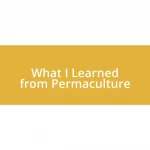Key takeaways:
- Grandma’s cooking was intuitive and rooted in love, with techniques like using fresh herbs and tasting as you go.
- Reviving traditional techniques such as fermentation, slow cooking, and making homemade stocks helps connect with heritage and nourish relationships.
- Finding original ingredients involves community connection, as it enhances the flavor and preserves the stories behind the cooking process.
- Documenting and sharing the culinary journey deepens the connection to food and inspires others to explore their family recipes.

Understanding Grandma’s Cooking Secrets
Grandma’s recipes often come shrouded in mystery. I remember spending afternoons in her warm kitchen, the air fragrant with spices, as she would measure ingredients not with cups but with a pinch or a handful. Isn’t it fascinating how those little “secrets” she swore by often seemed like magical incantations that brought dishes to life?
One of her favorite tricks was using freshly picked herbs—her garden was a treasure trove. When I first tried to replicate her famous rosemary chicken, I learned the hard way that dried herbs simply couldn’t capture the same vibrancy. Have you ever experienced that moment when you realize a simple ingredient can make or break a recipe? It really made me appreciate how intuitive her cooking was, rooted in love and experience rather than just following a recipe.
I still recall her kitchen mantra: “Taste as you go.” It was more than just good advice; it was a philosophy, an invitation to engage with the food. When I started reviving her recipes, I realized that missing her subtle techniques made them feel incomplete. Isn’t it incredible how food can connect us to our memories and the loved ones who taught us?

Reviving Traditional Techniques
Reviving traditional cooking techniques can be a deeply rewarding experience, as it allows me to connect not only with my heritage but also with the essence of home-cooked meals. I remember the first time I tried my hand at hand-rolling pasta just like Grandma did. The texture, the feel of the dough as it slid through my fingers, brought back a wave of nostalgia. That tactile connection transformed a simple dish into a heartfelt homage.
Here are some traditional techniques worth incorporating:
- Fermentation: Emulating Grandma’s method of pickling vegetables makes me appreciate the flavors that develop over time.
- Slow Cooking: Using a cast-iron pot for stews allows flavors to meld beautifully, just like it did in her kitchen.
- Homemade Stocks: Crafting stock from scratch transforms everyday soups, giving them depth and richness reminiscent of family gatherings.
Moments like these remind me that food isn’t just about nutrition; it’s about preserving history and nurturing relationships through shared meals. All these little details contribute to honoring her legacy, and each effort brings me closer to understanding the heart of her cuisine.

Finding Original Ingredients
Finding original ingredients can feel like an adventure, much like treasure hunting in my grandmother’s memories. I vividly recall scouring local farmers’ markets, searching for those unique spices or heirloom varieties of vegetables she often used. The thrill of discovering a rare ingredient, such as organic heirloom tomatoes, transported me straight back to her sunny backyard garden where everything tasted richer and more vibrant. Isn’t it interesting how the source of an ingredient can transform a dish?
Sometimes, I would rely on old connections within the community to find those special items. I remember chatting with a sweet elderly neighbor who claimed to grow the best basil in town. Calling her up for tips not only helped me source fresh, fragrant basil but also led to lovely conversations about her own family recipes. Have you ever noticed how sharing culinary stories can bridge generations and foster a sense of belonging?
For me, reviving Grandma’s recipes meant also reviving the relationships tied to those ingredients. I’m not just looking for the right spices; I’m reaching out to local farms, remembering where certain foods come from, and sharing experiences with fellow food lovers. Finding original ingredients isn’t just about the component itself; it’s about connecting to a larger story and honoring the heart behind every dish.
| Ingredient Type | Source |
|---|---|
| Heirloom Tomatoes | Local Farmers’ Market |
| Organic Basil | Community Gardens/Friends |

Adapting Recipes for Modern Tastes
Adapting Grandma’s old recipes to fit modern tastes can feel like a game of culinary balance. When I first tried to lighten up her heavy lasagna, I remember thinking, “Will it still taste like home?” I swapped in zucchini noodles for the pasta and used ricotta made from almond milk. To my surprise, it brought out the sauce’s flavors without losing the comforting essence of that beloved dish. What a joy it was to realize that I could still pay homage to tradition while making it more accessible!
Sometimes, modernizing a recipe means experimenting with flavors I never would have dared to before. For instance, when making her classic apple pie, I decided to infuse ginger and cardamom instead of just cinnamon. Adjusting those familiar tastes opened up a whole new dimension of flavor. It was fascinating to see how one small twist can breathe new life into a cherished dish while still allowing me to cherish the memories of Grandma’s apple pie cooling on the windowsill. Have you ever thought about how a simple substitution can spark such joy?
While adapting recipes, I make sure to preserve the integrity of the dish, keeping its soul intact. When tweaking those age-old family recipes, I often ask myself, “What was Grandma trying to achieve with this meal?” By infusing fresh ingredients, reducing sugar, or even introducing alternative sweeteners, I find that I’m not just changing a recipe; I’m evolving it into something that resonates with current palates. This journey of adaptation is as much about respect as it is about innovation, creating meals that my family can relate to in today’s world while honoring the past.

Documenting the Recipe Revival Process
Documenting the recipe revival process has been a heartwarming journey for me. I remember setting up a cozy corner in my kitchen, notebook in hand, jotting down every step of each recipe as I experimented. Capturing memories alongside measurements has become like a scrapbook of flavors, and I find myself smiling every time I look back at those notes, reliving the moments spent cooking with my grandma. Isn’t it incredible how the act of writing can deepen our connection to food?
I often take photos during the cooking process too, capturing not just the end results but the stages leading up to them. Each image tells a story—like the time I mixed the dough for her famous chocolate chip cookies and it ended up a bit too crumbly. That little mishap turned into a chat about the importance of balance and adjusting to our surroundings. How can we not laugh at ourselves when cooking, especially when it leads to inside jokes and shared smiles around a table?
Additionally, I’ve started creating video snippets while I cook, sharing my attempts and adaptations with family and friends. This has allowed me to invite them into the process, almost like having them at my kitchen counter, tasting the nostalgia in every bite. I can’t help but wonder, what if more people documented their culinary journeys? By putting my experiences out there, I hope to inspire others to dig through their own family recipes and discover the joy of bringing those flavors back to life.

Sharing Your Culinary Journey
Sharing my culinary journey has transformed my kitchen into a gallery of memories. I often find myself reminiscing about the laughter and stories that filled Grandma’s kitchen, particularly that one time we tried to make her famous honey-butter biscuits together. The dough flourished with each fold, and her joyful giggles filled the air as she taught me the importance of patience in cooking. Do you remember a dish that reminds you of your own family gatherings?
I love sharing not just the recipes, but the stories behind them. There’s something magical about the way food connects us to our roots. While making her creamy potato salad, I recalled how Grandma would narrate tales of her childhood summers. Those little anecdotes make each bite packed with nostalgia, and I can’t help but wonder—how many stories do our dishes tell, waiting to be uncovered?
Through social media, I’ve found a way to share this journey with a wider audience. I’ve posted my trials and triumphs, and it’s delightful to receive messages from friends trying my versions of family recipes. One friend even told me how my take on Grandma’s beef stew inspired her to revive her own grandmother’s spaghetti sauce recipe, sparking a whole new culinary exploration in her family. Isn’t it fascinating how sharing our journeys can create such a ripple effect, encouraging others to connect with their own heritage?















